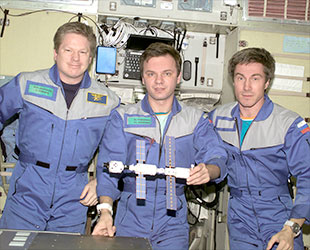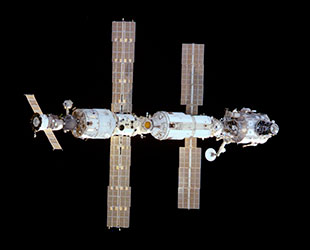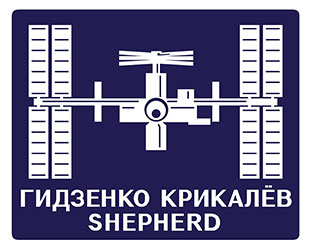Nov. 2, 2015 — A week into taking up residency on board the International Space Station, Bill Shepherd closed out the first entry in his new (space) ship's log with a note to those supporting him and his crewmates on the ground.
"We have all written some space history," the Expedition 1 commander wrote.
Now, 15 years later, Shepherd's focus is on the future and how what he helped to start might influence what happens next.
"What does Space Station mean in the context of the next century, the next millennium? I think it is very exciting to wonder just how far this will go," he told collectSPACE.
"We learned a lot doing this," he said. "I think it is a good road map for bigger things in the future."

Expedition 1 crewmates Bill Shepherd, Yuri Gidzenko and Sergei Krikalev pose with a model of the space station. (NASA) |
On Nov. 2, 2000, at 5:23 a.m. EST (1023 GMT), astronaut Bill Shepherd and cosmonauts Sergei Krikalev and Yuri Gidzenko entered the station to become its first resident crew. Up to that point, Shepherd had logged just 18 days in space on three short space shuttle missions. Now, he was beginning a four and a half month stay on the orbiting outpost.
His two Russian flight engineers were more experienced. Krikalev and Gidzenko had each spent at least six months on board the former Russian space station Mir.
"Sergei had flown and been in space for more than a year aboard Mir, so my sense of what we were doing was that I was with two guys who knew a lot about what to expect and what had to be done," Shepherd recalled. "So I was pretty relaxed about that. And actually Sergei was the first guy to open the hatch and go in."
The space station was a lot smaller then. First established in 1998 with the docking of the United States' Unity node to Russia's Zarya functional cargo block, by the time that the Expedition 1 crew arrived two years later, the soon-to-be-burgeoning complex had just one more room, Russia's Zvezda service module.
Still, there was much to be done.

The International Space Station, as it looked when the first crew arrived in 2000. From left to right: Soyuz, Zvezda service module, Zarya functional cargo block and the U.S. Unity node. (NASA) |
"Our first day was extremely hectic," Shepherd described. "Finding equipment, getting the right procedures out, and getting through the first day was extremely hectic. It went okay, not without incident, but fortunately no major ones."
"It was kind of like trying to build a house and live in it at the same time," he noted.
For the first three months of their 137 days on the station, communication with the ground were intermittent, meaning that Shepherd, as commander, had control.
"Our comm links for the first two-thirds of our expedition were extremely sparse," Shepherd said. "So the crew had to operate much more on their own than I believe they do today and what had been our previous experience. I think you have to go back to Mercury and Gemini to really get a crew environment that was that separated from its ground control."
Fifteen years later, the current Expedition 45 crew has it much different. Since being completed in 2011, the space station now has the same pressurized volume as a Boeing 747 jetliner, offering more livable room than a conventional six-bedroom house. The six crew members onboard are in almost constant contact with the ground and have access to the internet.
On Expedition 1, Shepherd, Krikalev and Gidzenko carried out 22 science experiments. Today, the crew is expected to complete 191 science investigations during Expeditions 45 and 46.

The International Space Station Expedition 1 insignia. (NASA) |
"[The space station's] form right now is very close to what was laid down about 20 years ago," Shepherd said.
It is where the outpost was altered however, that traces of Shepherd's legacy can still be found in space.
"The first expedition had a number of things that we put in place, some obvious, some not so obvious," he stated. "A good example of that [is that] we had a need to close off a ventilation duct. I forget why. The flow was not right or the pressurization was not right, so we fabricated a little cover out of aluminum and put it on this duct."
"I wrote on the back of it that this was something that was manufactured by the first expedition, figuring that no one would ever see that. About a year and a half ago though, [the space station crew] were doing something and had to get in that duct and pulled that piece off. I now have it in my house right now," Shepherd revealed.
"There are a few other things hidden away in various parts of the original modules on Space Station that I don't think people have found yet — but some day," he said.
